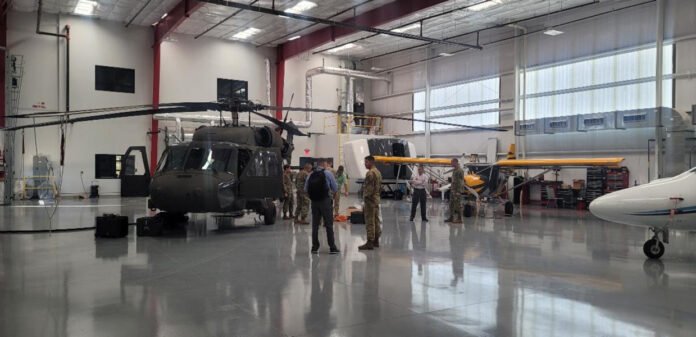HUNTSVILLE – One of Huntsville’s exciting avionics software startups, Avilution, soared to new heights recently with the successful demonstration of its new experimental technologies.
The demonstration was at the Army’s Experimental Demonstration Gateway Exercise, known as EDGE 23, in May at the Yuma (Ariz.) Proving Ground.
“The most important part of Avilution’s EDGE exercise, in my view, was demonstrating the ability to leverage our highly modular design philosophy to provide new capabilities (even entirely new data items) without requiring changes to the Operational Flight Program,” said Avilution founder and CEO Mark Spencer.
Because of the critical need to ensure Army aircraft are at their peak combat capability, the Army is implementing a Modular Open System Approach in their modernization efforts.
This approach focuses on maximizing interoperability and the ability to easily and rapidly deploy new technologies with minimal disruption to operations while still keeping cost manageable.
At EDGE, the Avilution team, in collaboration with the Army, showed off its capabilities for leveraging MOSA, showcasing its eXtensible Flight System’s ability to perform extremely rapid, realtime software integration – including the ability to implement features in the field in real time.
A tabletop setup with a UH-60V CDU and a CH-47F CDU, each tuning the same PRC-167 radio showed a practical example of 95% reuse of code between the Blackhawk and Chinook platforms.
Leveraging the Blackhawk’s MOSA architecture, Avilution and Northrop Grumman were able to quickly integrate the PRC-167 radio application and demonstrate the full system operating in a Georgia National Guard Blackhawk as a ground demonstration.
J.T. Naylor, who leads Northrop Grumman’s strategy for UH-60V and MOSA architecture development, was pleased with the demonstration.
“This is the holy grail for Army Aviation – the ability to rapidly integrate operational capability without the onerous timelines, cost and proprietary hurdles that have historically plagued our efforts,” Naylor said. “That’s why the Army initiated the UH-60V program, to break that paradigm.
“This demonstration shows that we really can implement new operational capability in weeks rather than years,” he added.
While an airworthiness release was not sought for purposes of the demonstration, Northrop Grumman performed an “All LRU test” to confirm the changes worked as intended with no adverse impact to aircraft operation.
According to Spencer, the initial prototype implementation for the Blackhawk took 27 days to implement, with the prototype later extended to support the Chinook in only 3 days.
The project transitioned from a virtual “proof of concept” demonstration to implementation of National Guard-specific requirements and ultimately installation and ground demonstration on the actual UH60V Blackhawk within a three-month period after the contract was awarded.
This work builds upon Avilution’s prior Army Phase II Small Business Innovation Research Contract.
While this demonstration was geared toward the Department of Defense sector, Avilution’s MOSA implementation demonstrates the potential commercial capabilities of XFS as well.
Originally developed for the general aviation market at private expense, XFS was matured through multiple Army and Air Force Phase II SBIR contracts from 2018 through 2023.
During the four days of the exercise, Avilution was added support for P25 call groups and a Guard monitor function on the PRC-167 radio, and was also able to implement support for interoperating with another Army PRC-158 radio.
“All three capabilities we developed and demonstrated at EDGE were new, required no new lines of code or software recompiles, and were able to move from idea to implementation on the actual aircraft in literally a matter of hours,” Spencer said. “This demonstrates exactly the kind of rapid capability development that the Army is seeking to be able to address a highly dynamic environment.”
J.T. Naylor, who leads Northrop Grumman’s strategy for UH-60V and MOSA architecture development, was pleased with the successful demonstration.
“This is the holy grail for Army Aviation – the ability to rapidly integrate operational capability without the onerous timelines, cost and proprietary hurdles that have historically plagued our efforts,” Naylor said. “That’s why the Army initiated the UH-60V program, to break that paradigm.
“This demonstration shows that we really can implement new operational capability in weeks rather than years,” he added.
Don’t miss out! Subscribe to our email newsletter to have all our smart stories delivered to your inbox.



